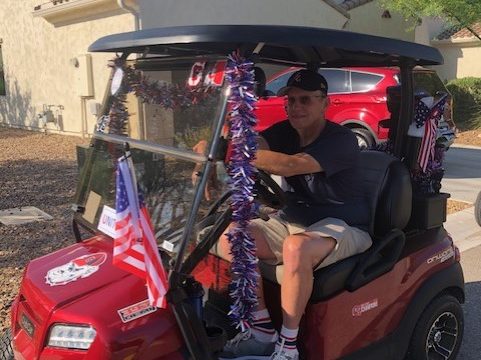Lee Parks is 64. He was born in Gainesville, moved away but “came home” in 1984 and practiced law here before moving to the Arizona desert south of Tucson in January following the 2021 passing of his wife. We wanted to know what it was like to go from one extreme summertime climate to one that was polar opposite. So, a couple of weeks ago, we asked him.
*Has getting used to the new climate been difficult? The hot summer here has not been that difficult for me to adapt to. My high school years were spent in southern Spain, when dad was stationed at the Naval base in Rota, Spain in the heart of Andalusia. That area has a climate very similar to where I live now. The tricks are to stay well hydrated and to plan the outdoor activities, such as golf or pickleball, early in the morning or early in the evening. The heat of the afternoon is the time for everyone to stay indoors or runs errands.
*And just how hot has it been since you’ve been out there? The hottest it has gotten here has been 109, which we had during the week of the 4th of July.
*What is the first rule of survival? First and foremost, stay hydrated. No one goes outside without having at least one container of water or other proper hydration drink (not caffeine or alcohol; there’s a time and place for those, but outside combatting the heat is not that time). The other is to try to schedule the day to be inside during the afternoon hours when it is the hottest.
*Have you tried frying the proverbial egg on the sidewalk? No, not with the price of eggs.
*So, what about this “dry” heat? We often hear things like “Oh, the hot weather out there is not that bad because it’s ‘dry’ heat.” Fact or fiction? There is a definite difference between a humid heat and a dry heat. The biggest thing is learning that dry heat does make a difference. As I told my dad, I’ll take our 105 actual temperature over north Georgia’s heat index of 105 with high humidity any day, which were the conditions the weekend before July 4! I can much easily tolerate straight heat without having my clothes becoming drenching wet and sticking to me within minutes of being outside. The body seems to adjust to the dry heat a lot easier than it does to heat plus humidity.
*What was winter like? Winter was mainly in the high 30s-low 40s in the mornings, warming up to the mid-40s to low 50s during the days. We had two mornings when we woke up to about an inch of snow on the ground (we are in the desert, but we also are at about 3000 feet elevation, with three mountain ranges ringing us on three sides, the Santa Rita mountains being about 10 miles away). No one freaked out about it, no runs on grocery stores, and the snow was gone by 9:30 am.
*What do you miss most about Gainesville? Other than the people, I miss 2Dog, Longstreet Cafe, grits and fried okra. Without pine pollen, I made it through Spring without allergies.
*You will soon have spent one winter and one summer there. What’s your advice for anyone thinking of making the move that you did? Bring shorts, short sleeve shirts, an appetite for good Mexican food and the Sonoran hot dog (it’s too complicated to describe, you just have to eat one), and an understanding that you’re not in Gainesville anymore.
Parks says golf carts are a “necessity” where he lives. He’s pictured with his while it was still decorated for his community’s July 4 golf cart parade. He says he bought it there and chose this one because the colors match those of his favorite college football team. Besides, he added, “Too many Michigan and Iowa fans out here.”
(EDITOR’S NOTE: Tucson, which, as Parks said, is close to where he lives, has hit a temperature of 100 or more 45 days so far this year, the city’s longest streak on record, its hottest July on record and hottest single month on record, according to the National Weather Service. The highest temperature recorded there during July this year was 112 which occurred on four days during the month.)


